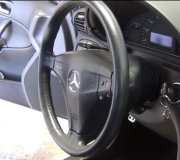Do your dash lights work? Many people don't realize there is no ground wire in Chrysler's radio connectors; that's why they use a separate ground strap or wire. By using an ohm meter, people mistakenly think they found a ground wire but it's actually the dash light wire. When you tie that wire to the new radio ground wire or case, you are tying it to ground through the antenna plug's ground shield. When you turn on the headlights and turn up the dash light rheostat, the radio becomes a short circuit and the dash light fuse blows.
The radio might work at times because it is grounded through the antenna, but that is a very poor ground and could be intermittent.
Put the ten amp fuse back in the fuse box. The wiring can't handle 15 amps. The fuse on the back of the radio is not meant to be easy to get to. It's only there to protect the vehicle from people who change the value of fuses in the easy-to-reach fuse box. Plus, in the rare event your radio causes a fire, and the insurance adjuster finds the wrong fuse, (and they will), they may decline your claim. Besides, fuses don't cause intermittent problems if they're the wrong value. They are good or bad, no in between. Of course they could be loose in the socket, but that's more common in '96 and newer Caravans.
Be aware too that there's two power wires, not just one. One is hot all the time for the clock and station memory. I don't know about after-market stuff, but original Chrysler radios have a variety of symptoms, depending on model number, if the fuse is blown for the memory circuit. Some are totally dead, some just have no sound, but the cassette runs and the display works, some work fine but loose the time and stations when the ignition switch is turned off.
Finally, not to pick on you, but I can't tell you how many problems have been solved by fixing the wiring splices after the installer says "I know the splices are good". If you twisted the old and new wires together, or worse yet, you used crimp-style butt connectors, consider yourself lucky if the radio works at all. The worst splice of all is the squeeze-style quick splices that slide across the wire's insulation. They're commonly called "Scotch-Lok" connectors. These should never be used where they can get wet, such as under the hood or for trailer wiring. These are normally meant for 12 gauge wire. Radio wiring in the dash is 14 gauge and a lot of after-market radios use 16 gauge wire. These wires are too small so the Scotch-Lok connectors don't make good contact with the copper wire.
Chrysler original radios are very forgiving of intermittent speaker connections, but most high-power after-market radios will pop the audio output ICs if the speaker wires are shorted or grounded.
To make the best quality splice connections, strip only 1/8" to 1/4" of insulation from the end of each wire. Slide a 1" piece of heat-shrink tubing onto one wire, then slide the ends of the two wires together so the copper strands slide in between each other. Press any sharp wire ends down, then solder them together. Touch the tip of the soldering iron onto the exposed wire, and touch the solder to the other side of the splice; don't apply the solder to the iron tip. When it melts, the solder will flow toward the heat source. When the solder cools, feel for any sharp points. Press any points down so they won't pierce the heat-shrink tubing. Slide the tubing over the splice and warm it with a match or lighter. Don't over-do it as the tubing will melt and split open if overheated.
Twisting and taping wire splices is a sure way to have problems.
Caradiodoc
Thursday, March 19th, 2009 AT 6:49 PM


